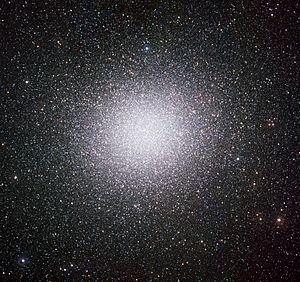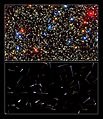Omega Centauri facts for kids

Omega Centauri (also called ω Cen or NGC 5139) is a huge group of stars known as a globular cluster. You can find it in the constellation called Centaurus. It is very far away, about 15,800 light-years from Earth.
Omega Centauri is the biggest globular cluster in our home galaxy, the Milky Way. It stretches about 150 light-years across. This amazing cluster holds around 10 million stars! Together, these stars weigh as much as 4 million of our Sun.
Scientists think Omega Centauri might be special. It is so different from other star clusters that it might have come from somewhere else. Some believe it could be the leftover core of a smaller dwarf galaxy that was pulled apart.
Contents
Discovering Omega Centauri
People have known about Omega Centauri for a very long time.
Early Observations
- Around 150 A.D., a Greek-Roman astronomer named Ptolemy wrote about this object. He included it in his famous book, Almagest.
- Later, in 1677, an English astronomer named Edmond Halley saw it again. He was using a telescope from the island of Saint Helena. Halley listed it as something that wasn't a single star.
- In 1715, Halley published his findings. He described Omega Centauri as one of six "luminous spots or patches." This was in a science paper for the Royal Society.
A Bright and Massive Cluster
Omega Centauri is one of the few star clusters you can see without a telescope. If you are in a dark place away from city lights, it looks almost as big as the full Moon!
Size and Brightness
- It is the brightest and largest globular cluster we know of in the Milky Way.
- It is also the most massive, weighing as much as 4 million Suns.
- Among all the globular clusters in our nearby group of galaxies (the Local Group), only one is bigger. That one is called Mayall II, and it orbits the Andromeda Galaxy.
Omega Centauri travels through the Milky Way galaxy. It is home to several million very old stars. Scientists believe this cluster is about 12 billion years old.
Stars Packed Together
In the very center of Omega Centauri, the stars are incredibly close. On average, they are only about 0.1 light-years apart. That's a tiny distance in space terms!
Images for kids
See also
 In Spanish: Omega Centauri para niños
In Spanish: Omega Centauri para niños


